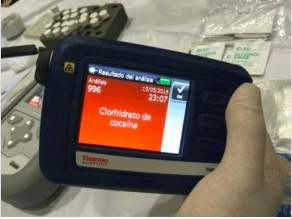Officers Risk Fentanyl Exposure To Ensure Public Safety

TruNarc scanner
Source: U.S. Department of State
According to KREM 2, as of October 2017, the Oregon State Police (OSP) joined the growing ranks of law enforcement organizations around the country that will limit roadside testing of suspected drugs due to the potential exposure to dangerous drugs such as fentanyl. Officers will only do the tests if “necessary to avert the risk of death, serious physical injury or substantial public health risks,” reported KREM2.
Captain Mark Kruger of the Portland Police Bureau (PPB) said more police departments are instituting similar policies. The PPB will also not be entirely banning roadside testing because of the excellent training officers receive there about handling suspicious substances. The TruNarc device, a handheld narcotics analyzer, is a popular choice for law enforcement agencies, but the $20,000 price tag is an issue. At this point, OSP only has one TruNarc and PPB ordered one. Kruger said, “We want to add this additional tool so we can test other new drugs that are coming on the scene like fentanyl or other synthetic opioids that we're not currently able to test.”
The U.S. Drug Enforcement Administration (DEA) released a video in June 2013 warning police and public alike to be cautious about anything they suspect might contain fentanyl. In the video, two Atlantic County, NJ agents told of their accidental exposure to fentanyl. Jack Riley, the Deputy Administrator at the DEA, stressed in the video that even a minute amount of fentanyl can be deadly and that doing roadside testing of drugs was no longer recommended.
Since PSM published this article in 2018, an increasing number of experts have agreed that it is not possible for a person to suffer fentanyl poisoning through passive exposure.